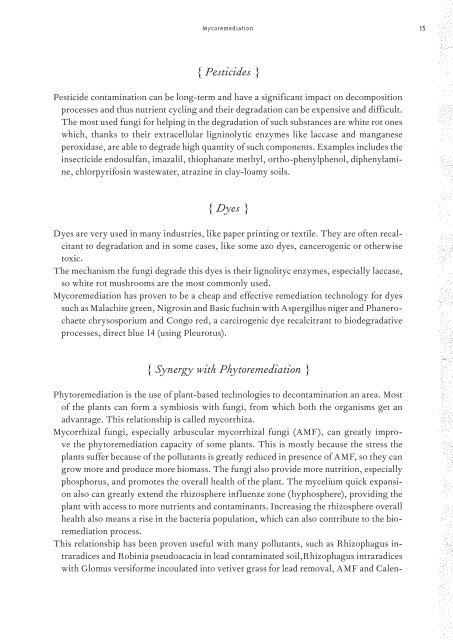Logbuch_17x24Druck_einzelseiten
Create successful ePaper yourself
Turn your PDF publications into a flip-book with our unique Google optimized e-Paper software.
Mycoremediation<br />
15<br />
{ Pesticides }<br />
Pesticide contamination can be long-term and have a significant impact on decomposition<br />
processes and thus nutrient cycling and their degradation can be expensive and difficult.<br />
The most used fungi for helping in the degradation of such substances are white rot ones<br />
which, thanks to their extracellular ligninolytic enzymes like laccase and manganese<br />
peroxidase, are able to degrade high quantity of such components. Examples includes the<br />
insecticide endosulfan, imazalil, thiophanate methyl, ortho-phenylphenol, diphenylamine,<br />
chlorpyrifosin wastewater, atrazine in clay-loamy soils.<br />
{ Dyes }<br />
Dyes are very used in many industries, like paper printing or textile. They are often recalcitant<br />
to degradation and in some cases, like some azo dyes, cancerogenic or otherwise<br />
toxic.<br />
The mechanism the fungi degrade this dyes is their lignolityc enzymes, especially laccase,<br />
so white rot mushrooms are the most commonly used.<br />
Mycoremediation has proven to be a cheap and effective remediation technology for dyes<br />
such as Malachite green, Nigrosin and Basic fuchsin with Aspergillus niger and Phanerochaete<br />
chrysosporium and Congo red, a carcirogenic dye recalcitrant to biodegradative<br />
processes, direct blue 14 (using Pleurotus).<br />
{ Synergy with Phytoremediation }<br />
Phytoremediation is the use of plant-based technologies to decontamination an area. Most<br />
of the plants can form a symbiosis with fungi, from which both the organisms get an<br />
advantage. This relationship is called mycorrhiza.<br />
Mycorrhizal fungi, especially arbuscular mycorrhizal fungi (AMF), can greatly improve<br />
the phytoremediation capacity of some plants. This is mostly because the stress the<br />
plants suffer because of the pollutants is greatly reduced in presence of AMF, so they can<br />
grow more and produce more biomass. The fungi also provide more nutrition, especially<br />
phosphorus, and promotes the overall health of the plant. The mycelium quick expansion<br />
also can greatly extend the rhizosphere influenze zone (hyphosphere), providing the<br />
plant with access to more nutrients and contaminants. Increasing the rhizosphere overall<br />
health also means a rise in the bacteria population, which can also contribute to the bioremediation<br />
process.<br />
This relationship has been proven useful with many pollutants, such as Rhizophagus intraradices<br />
and Robinia pseudoacacia in lead contaminated soil,Rhizophagus intraradices<br />
with Glomus versiforme incoulated into vetiver grass for lead removal, AMF and Calen-


